Plurality
Subsections
Plurality
Everything up to now has been focused on what we call singular equations. Singular equations are simple in a particular way: they are solved in a sequence of steps that unambiguously leads to a single solution. One equation that is NOT singular is ![]() . It has two solutions, x = 2 and x = 0. When solving it, we morph the each side by taking its square root:
. It has two solutions, x = 2 and x = 0. When solving it, we morph the each side by taking its square root:
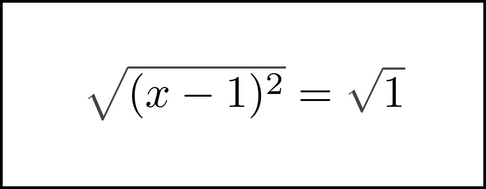
In doing this we get two possible values for the right hand side:
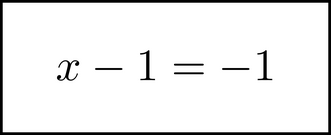
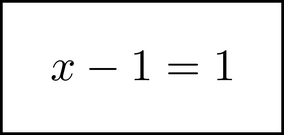
The techniques we've introduced so far all involve working with a single picture; having a 'split' like this adds some complexity. Sometimes we can adjust the situation in ways that let us continue with a single picture (for example, if we work with the symbol ![]() ). Yet there are some cases, like what we have here, where that strategy will not get you all the way to the final solutions. Other methods - conveniently covered in this chapter! - can be employed to reveal the solutions in these situations.
). Yet there are some cases, like what we have here, where that strategy will not get you all the way to the final solutions. Other methods - conveniently covered in this chapter! - can be employed to reveal the solutions in these situations.
The definitions for singular and plural equations given before have been a little vague. This is because the concepts needed to give a precise definition had not been fully introduced. Now we can say that an equation is singular if can be solved by starting with a single equation image, and by applying symbol motions, fusions/fissions, and other morphs, arrive at a single solution. The key word is single. If we get a situation like the above, where we have two or more valid choices for where the equation is headed, it's a plural equation.
As we work the equation above, we arrive at a 'split': a point where a normal, single image cannot represent the two or more eventual solutions. As stated, at that point, the equations are

and

This chapter describes two strategies for solving plural equations internally. We'll introduce the first one by using it to finish solving this equation.
Multi-images
The first method is to have what is called a multi-image, which is just a single image that has both equations after the split:
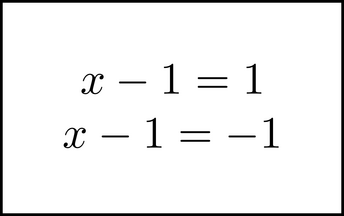
In other words, instead of just visualizing one equation, you visualize both of them. You then do the manipulations for each individually.
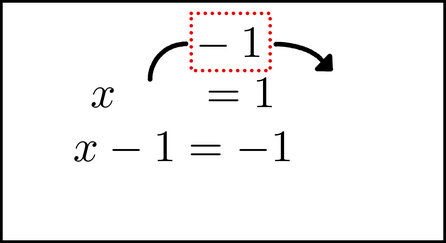
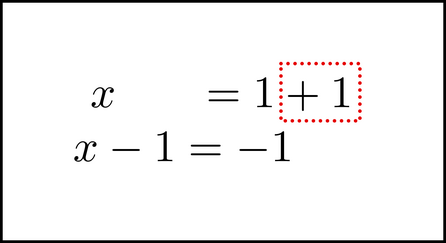
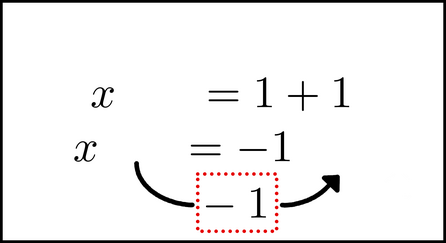
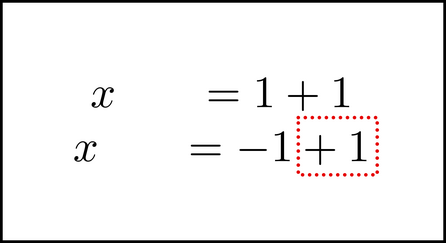
Here we did each equation one at a time. If you are good, you can solve both simultaneously.
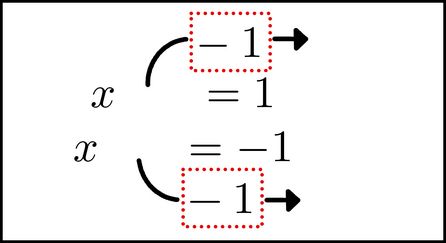
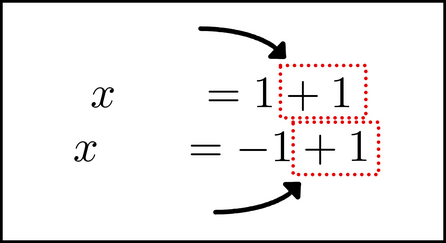
It is powerful to combine the use of multi-images with windowing. Visualizing several variations of the same equation at once is a lot of work. Because of the similarity, though, it is relatively easy to window them.
Subimages
Multi-images can take a lot of mental energy, especially if your equations are complex or if there is more than one split. What can help is to take the concept of a multi-image, and apply it to a portion of the equation's image, in a way that keeps the logic intact. This often makes solving the equation much easier.
We'll illustrate by showing how to solve quadratic equations using the general solution. As an example, we'll use ![]() , and plug in the formula
, and plug in the formula  . The figure we visualize becomes
. The figure we visualize becomes

which reduces to
The numerator has two legitimate values, -5 - 7 and -5 + 7. The basic idea of subimages is to have a single image that represents both solutions, as compactly as possible, while letting us solve for both. The dual image introduced near the start of this chapter partially satisfies all this.
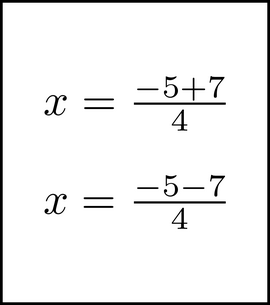
Yet this image does not represent the information as compactly as possible. The most compact image would be what we wrote above:
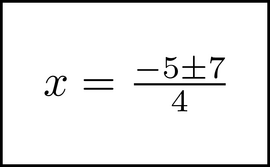
That's nice and all, but this image does not meet the third criteria - letting us continue solving for both values. (That is, at this point in solving the equation. Notice that prior to this step, it did.) What helps here is a new method of presenting the situation visually. Visualize just one of the solutions:
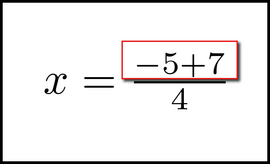
I have taken the liberty of chunking the -5 + 7 for you. Notice that the outline is a little different. Pretend that the -5 + 7 is like a card that you can pick up and remove from the image:
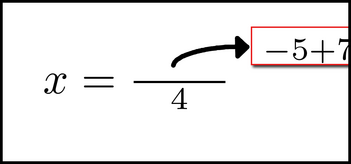
And you can drop another card in its place, representing the other solution:
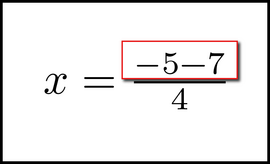
Now you have a modular system. Your image can represent either solution depending on which card you place on (in) it.
You can work with the image in the card just like any expression, using everything in this book.

becomes
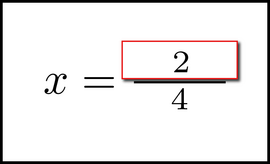
We call a card like this a subimage. It is a group of symbols in the equation that you mark off as separate. It is like a chunk, but more definite in its boundary, and more independent from the expression it lives in.
You can solve plural equations by using multiple subimages (cards). There are several ways to visualize this. One is to see the subimages partly stacked:
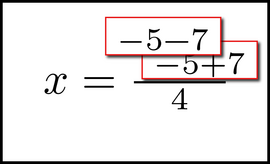
Here they are offset so that you can tell what is on both. You can also stack them directly on top of each other:
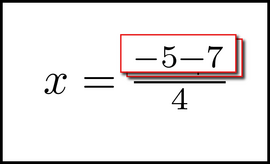
These methods are both fine, and there are other ways too. Use the variation that works best for you.
When you want to work with the other solution, take that and swap it into the foreground of the image.
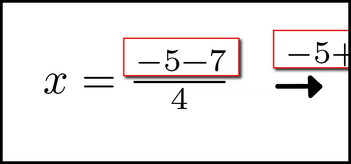
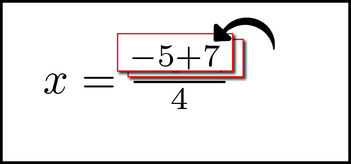
Having defined the subimages, you are set up to find all the solutions. It's usually best to work (simplify) within the subimages first, and when they are all done, move forward from there. We'll solve within the foreground subimage first.
 becomes
becomes 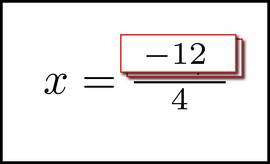
Now that the top subimage is done, bring the bottom one up and work it.
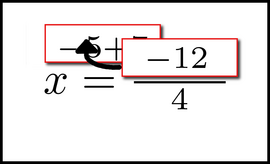
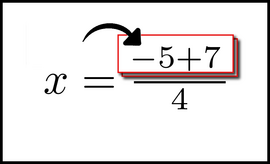
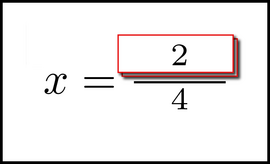
Now that we've reduced everything within the subimages, we continue with the rest of the equation outside of them. Do this by bringing parts of the equation into each subimage, then simplifying. Viewing the equation like this,
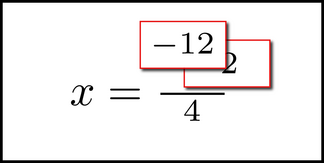
bring the ![]() into each subimage.
into each subimage.
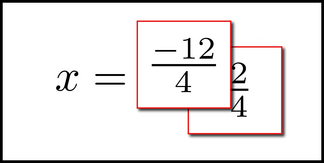
You can do this with each subimage, one at a time, or do it with both at once. Next, just simplify within each card, starting with the top one,
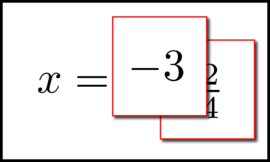
then swapping to the other one and simplifying it.
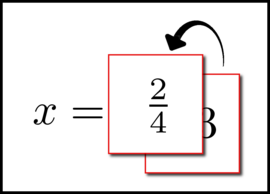
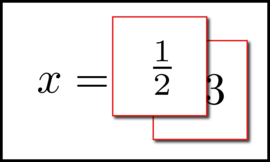
You get the two solutions, ![]() and x = -3.
and x = -3.
In this example, we are already pretty close to the solution when the split occurs and we start using subimages. With more complex situations, we will have more manipulations on the subimages themselves; here, we just had one. In larger equations, when it is time to bring part of the equation into a subimage, it is normally best to do that operation on all the subimages before moving on to the next operation. This may be confusing, so here is an example. Say we are solving this equation:
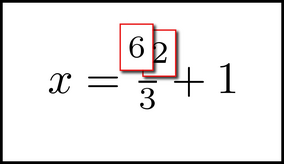
Here, we have had a split, and have already created two subimages. (That's a 6 in the top subimage and a 2 in the bottom one.) To get the pair of final solutions, we must do two things to each value: divide them by 3, then add 1 to the result. There are two approaches you can take to doing that. One path - the path that is generally recommended - is to first bring the ![]() into each subimage:
into each subimage:
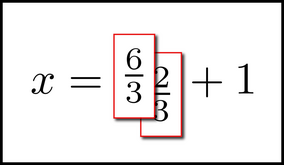
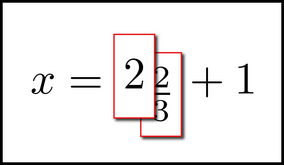
After doing this with both subimages, then bring the +1 into each subimage.
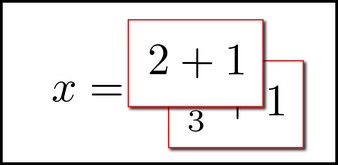
becomes
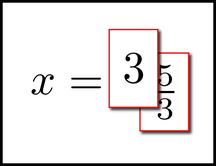
So like I said, all of that - bringing more and more of the surrounding equation into the subimages, one ``step'' at a time - is one path you can take, and the path that is generally recommended. The other path is to bring the whole equation into each subimage at once.
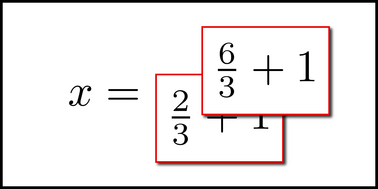
This is essentially envisioning a multi-image. With an equation as simple as this one, it is relatively easy to do this. With bigger equations, it usually not so easy, and subimages will be very handy.
At first, when solving plural equations, you will probably want to bring one operation at a time into the subimages. As you get better, you will be able to bring in several at a time. The more operations (steps) you can bring into the subimages at a time, the faster you will get to the solution, provided you bite off what you can chew.
Exercises
- Solve these equations using multi-images.
- Visualize each of these expressions using subimages. Focus on each version, one at a time, flipping through the different subimages.

-

-
 (You will flip through four different combinations.)
(You will flip through four different combinations.)
- Solve each of these equations by using subimages.


-
 ,
, 
1(a) y = -5 and y = 1 (b) x = -1 and x = 3 (c) x = 1 and x = -3
3(a)x = 1 and x = 4 (b) x = 0 and x = -4 (c) ![]() and
and ![]()